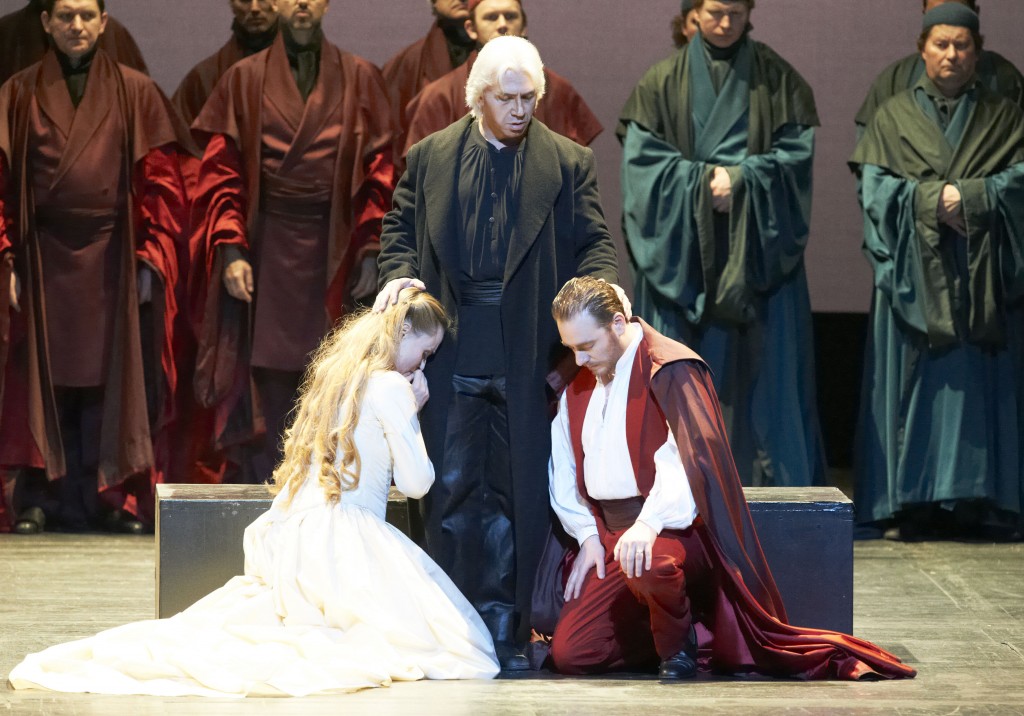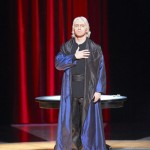 Those unfamiliar with Verdi’s Simon Boccanegra may find the plot unduly complicated. The Corsair Simon Boccanegra, elected Doge of Genoa, hopes to marry Fiesco’s daughter Maria who bears his child. But Maria dies and Fiesco swears revenge, claiming his grandaughter, now mysteriously disappeared. Cut to 25 years later. Maria, ‘Amelia’ orphaned as Grimaldi, has fallen in love with Gabriele Adorno. The Doge Boccanegra intends to marry her to his henchman Paulo, not realising ‘Amelia’ is his daughter, until their chance first meeting – an operatic highlight. Revengeful Paulo abducts Amelia; jealous Gabriele plots against Boccanegra , unaware the Doge is Amelia’s father; Simon is poisoned by Paulo…
Those unfamiliar with Verdi’s Simon Boccanegra may find the plot unduly complicated. The Corsair Simon Boccanegra, elected Doge of Genoa, hopes to marry Fiesco’s daughter Maria who bears his child. But Maria dies and Fiesco swears revenge, claiming his grandaughter, now mysteriously disappeared. Cut to 25 years later. Maria, ‘Amelia’ orphaned as Grimaldi, has fallen in love with Gabriele Adorno. The Doge Boccanegra intends to marry her to his henchman Paulo, not realising ‘Amelia’ is his daughter, until their chance first meeting – an operatic highlight. Revengeful Paulo abducts Amelia; jealous Gabriele plots against Boccanegra , unaware the Doge is Amelia’s father; Simon is poisoned by Paulo…
The political intrigues to Simon Boccanegra may seem irrelevant, mere spice to the plot. Except that the patchwork of feuding nation states- the background to Verdi’s operas- describes ‘Italy’ before unification in 1863. And Verdi identified with the Risorgimento; and his tuneful choruses, as the Prisoners’ march in Nabucco, were adopted as its anthems. The dying Simon Boccanegra exclaims ‘Let my grave be be an altar to the peace of Italy’. Simon has to be sacrificed to enable a new beginning to be inaugurated (under Adorno.) The Old Order has to be swept away- tainted with enmity, mistrust , the crimes of its rival parties.
The themes of forgiveness and reconciliation underly the opera, especially between Simon and the embittered Fiesco . Fiesco stalks the opera. He disappears after the Prologue , reappears later under another name, only to resurface at the end. Fiesco, Verdi’s jealous (Rigoletto) father role intransigently opposes Boccanegra’s marriage to Maria.
Also there are generational tensions. Some of the opera’s most powerful scenes deal with Gabriele’s raging jealousy of Simon, unwittingly suspecting older man and Doge of desiring and abusing Amelia. But in the closure Simon blesses his daughter’s marriage to Adorno. And Simon and Fiesco, ‘the father of Maria’, finally embrace tearfully. Symbolically, Fiesco, now the ‘messenger of peace’, gives his blessing to Amelia’s marriage to Adorno. So the opera, superficially, is defined by intrigues and strife, but its greatest scenes are full of humanity, its characters sympathetically drawn.
The highlights of this outstanding Vienna State Opera production were in the complex interaction of characters, the psychological insights revealed. So in the first confrontation of Simon Boccanegra and Fiesco, operatic titans meet head on. Dmitri Hvorostovsky as Simon was quite outstanding. As his counterweight, bass Ferruccio Furlanetto- who’s appeared with all the major opera houses since 1974- chillingly authorative.
Simon, in his opening scene agrees to be Doge- hitherto prevented – to win over Maria. Furlanetto, Verdi’s inconsolable father, echoes the depths of the ‘tormented spirit, who must suffer shame and grief’. In death ‘the merciful heavens have awarded Maria a martyr’s crown’. Fiesco thinks Simon has come to torment him. The irony is that Simon wanted to make ammends to Maria, ‘the innocent victim of his happy love’. But too late! she’s dead. Simon seeks peace. Fiesco’s replies, ‘there can be no peace until one of us is dead’. Thus, in the tragedy, the unrelenting Fiesco’s curse casts a shadow over the entire work.
In Verdi’s dramatic masterstroke, Simon finally confront the terrible truth, a palace in darkness. Fiesco, dagger raised, is poised for revenge. But the crowds rush in, lifting Simon shoulder high proclaiming him Doge. ‘Long live Simon , elected by the people!’
 Hvorostovsky enacts a moving study of Doge corroded by power. ‘Even water tastes bitter to the lips of a sovereign’-ironically drinking the poison chalice.’How heavy my heart is; how my limbs ache’. The sea offers him solace; dying, the sight of it reminds him of glory and fame.
Hvorostovsky enacts a moving study of Doge corroded by power. ‘Even water tastes bitter to the lips of a sovereign’-ironically drinking the poison chalice.’How heavy my heart is; how my limbs ache’. The sea offers him solace; dying, the sight of it reminds him of glory and fame.
Hvorostovsky’s Simon, white haired, majestic, deep timbred baritone, is contrasted to the youthful tenor Francesco Meli: virtuoso tenor against steadfast baritone. The impulsiveness of Gabriele- reflected by the glamour of the tenor- must be brought to order. Meli’s Gabriele was the other ‘matinee idol’. His Act 2 lament pleads merciful heaven to have pity on his suffering. He weeps, and begs on his knees. Meli’s rich, light tenor seems at times to croon; there are momentary woops in the voice. There was huge applause.
Amelia (Maria Poplavskaya)- new to me , not to ROH, the Met, Berlin, Zurich- is a superb soprano. She first appears, to pizzicato strings and horn accompaniment: day is breaking, and she hasn’t seen her beloved yet. In her (Act 1) Aria, ‘a heart without love is a heaven without joy’. Poplavskaya, a beautiful blonde with long tresses, is dressed in a white satin gown, In their Act 1 duet she’s described by Gabriele as ‘an angel come down from paradise’. But Amelia is shrouded in mystery. In Act 2, now in a scarlet gown to suggest her ambiguous virtue (to Gabriele), she begs Gabriele to keep her secret for a little longer: to banish fears from his heart.
Amelia is the agent of goodness and conciliation in the opera. In the ‘reunion’ between father and daughter, she promises ‘in sad times she will dry his tears; together they will enjoy supreme happiness’. Audience, moved to tears by Hvorostovky and Maria, fumbled discreetly for handkerchiefs.
The set pieces and crowd scenes are spectacular. In reconstruction of Doge’s palace, Simon (Act 1) in white robes sits isolated on Doge’s throne: overlooking opposing red and green ranks of councellors. At the moment (Prologue) when Fiesco draws his sword, the crowd rush the stage in support of their new Doge. The mood changes from high drama to street celebration and carnival. Vienna State Opera Chorus were thrilling.
Simon Boccanegra, though not as popular as Rigoletto , Traviata, and Aida , is considered by opera buffs Verdi’s most beautiful, (as in its lyrical orchestral opening.) Vienna State Opera orchestra, conducted by Paulo Carignani, were outstanding and authentic. Carignani has been conducting Vienna Opera since 1997. The handsome sets were traditional – elaborate panels side stage, white screen backstage showing palace facades. Director Peter Stein’s long-running production has proved its worth.
The 2011/2012 season debuted with Placido Domingo as Boccanegra. Notwithstanding, this production could hardly have been bettered. The applause was enthusiastic. Hvorostovsky, in spite of a pre-announced cold, returned again and again to acknowledge his fans. The encores lasted for a good 15 minutes.
11.03.2012
Photos: Maria Poplavskaya (Amelia), Dmitri Hvorostovsky (Simon Boccanegra), Francesco Meli (Gabriele Adorno);
Dmitri Hvorostovsky (Simon Boccanegra)
(c) Wiener Staatsoper/ Michael Pöhn

Hello There. I discovered your weblog using msn. That is an extremely well written article.